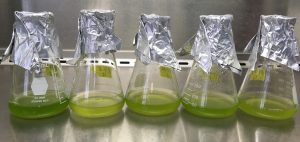Research
Current Projects
Understanding the role of the circadian clock in potato
With pending global climate change, species ranges and crop production regions will be altered. For example, growth of crops at more northern and cooler latitudes will require adaptation to altered daylengths. The circadian clock allows organisms to adjust their physiology to daily light/dark cycles. In humans, jet lag and poor health associated with shift work are due to the desynchronization of our body’s circadian clock with the current environmental cycle. In plants, the circadian clock regulates a wide array of processes ranging from photosynthesis to stress responses. Moreover, the circadian clock enables plants to measure day length, and therefore, anticipate seasonal changes, which vary depending on the latitude.
Circadian clocks generate oscillations with a period of about, but not exactly, 24h. Natural variation in this endogenous circadian period has been measured in animals, including humans, and plants. Our previous studies demonstrated that potato displays natural variation of circadian period. We also observe a potential link between changes in the circadian clock and the process of potato domestication (Hardigan et al., 2017). As part of a NSF-PGRP award we are investigating the role of the circadian period in the optimization of potato growth under different daylengths.
Circadian rhythms and light signaling in Nannochloropsis algae
Nannochloropsis species are small unicellular alga with a diameter of about 2 μm. Marine Nannochloropsis species are used as a source of fish food and omega-3 fatty acids. Due to their high lipid content, which is particularly elevated under nitrogen deprivation, these species have been considered as a potential source of biofuels. The genomes of several Nannochloropsis species have been sequenced. These organisms have genome sizes of ~30 Mb, containing ~9,000-12,000 genes, similar to the diatoms Phaeodactylum tricornutum and Thalassiosira pseudonana. Current research suggests that Nannochloropsis species are haploid. Clocks have been studied in cyanobacteria, plants, green alga, fungi and animals (Figure 3), however, the mechanisms underlying circadian rhythms and light signaling in Stramenopiles including Nannochloropsis are currently unknown.
The genome of N. oceanica CCMP1779 (Vieler et al., 2012) can be found here.
We have characterized the transcriptome of N. oceanica under light/dark cycles (Poliner et al., 2015) . We have also developed tools for overexpression, fluorescent and bioluminescence reporters in N. oceanica (Poliner et al., 2017). Our list of molecular tools for work on Nannochloropsis can be found in Tools. Our current research is focused on the Aureochrome family of photoreceptors that we have shown are involved in the synthesis of polyunsaturated fatty acids (Poliner et al., 2022).
